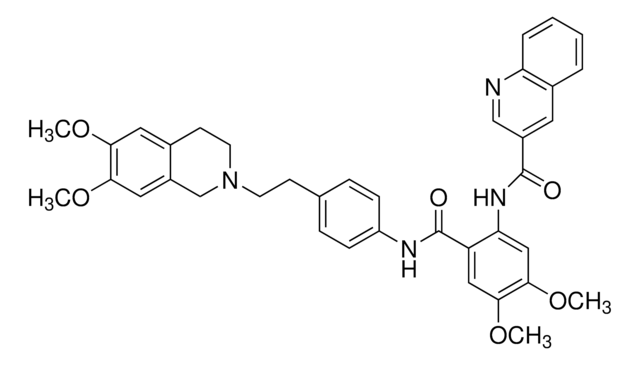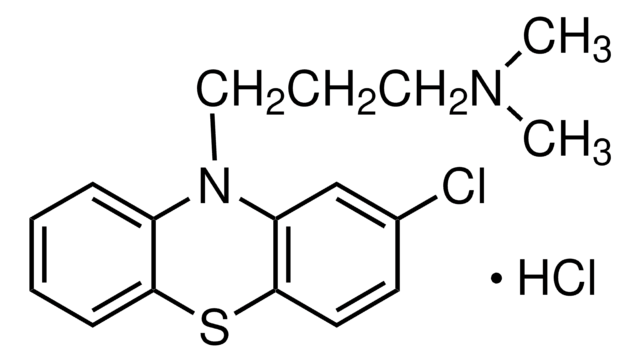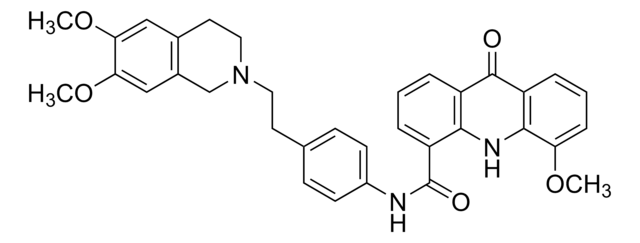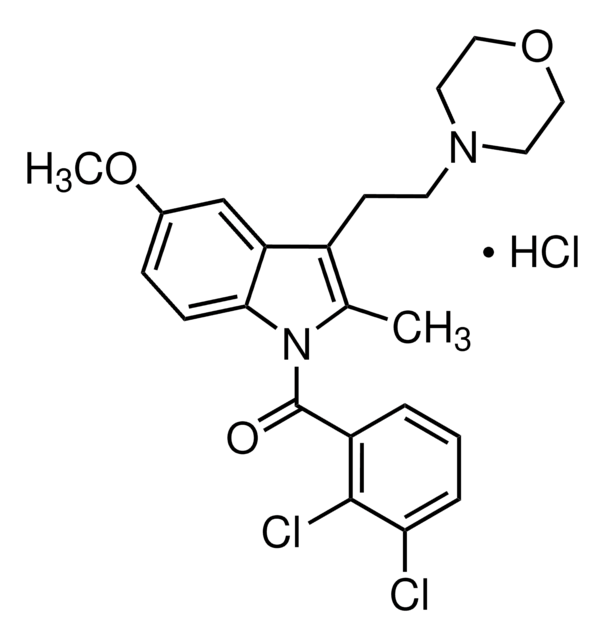SML3678
ML-SI3
≥98% (HPLC)
Sinonimo/i:
N-[2-[4-(2-Methoxyphenyl)-1-piperazinyl]cyclohexyl]benzenesulfonamide
Autenticatiper visualizzare i prezzi riservati alla tua organizzazione & contrattuali
About This Item
Formula empirica (notazione di Hill):
C23H31N3O3S
Numero CAS:
Peso molecolare:
429.58
Numero MDL:
Codice UNSPSC:
12352200
NACRES:
NA.77
Prodotti consigliati
Livello qualitativo
Saggio
≥98% (HPLC)
Forma fisica
powder
Colore
white to beige
Solubilità
DMSO: 2 mg/mL, clear
Temperatura di conservazione
-10 to -25°C
Azioni biochim/fisiol
ML-SI3 is a 4-diastereomer racemate (2 cis and 2 trans isomers) with a cation channel TRPML1-blocking (IC50 = 3.1 μM/trans, 18.5 μM/cis against 5 μM ML-SA1-induced cellular calcium response) and TRPML2-activating activity (EC50 = 3.3 μM/trans, 9.4 μM/cis), while exhibiting much weaker TRPML3 potency (EC50 = 28.5 μM/trans, IC50 = 29.0 μM/cis). ML-SI3 is shown to compete against ML-SA1 for binding the same TRPML1 hydrophobic cavity. Comparing with ML-SI1 (GW405833), ML-SI3 is more potent and not agonist-dependent, effectively antagonizing against TRPML1 activation by both MK6-83 and ML-SA1.
Codice della classe di stoccaggio
11 - Combustible Solids
Classe di pericolosità dell'acqua (WGK)
WGK 3
Punto d’infiammabilità (°F)
Not applicable
Punto d’infiammabilità (°C)
Not applicable
Certificati d'analisi (COA)
Cerca il Certificati d'analisi (COA) digitando il numero di lotto/batch corrispondente. I numeri di lotto o di batch sono stampati sull'etichetta dei prodotti dopo la parola ‘Lotto’ o ‘Batch’.
Possiedi già questo prodotto?
I documenti relativi ai prodotti acquistati recentemente sono disponibili nell’Archivio dei documenti.
Philip Schmiege et al.
Structure (London, England : 1993), 29(11), 1295-1302 (2021-06-26)
Transient receptor potential mucolipin 1 (TRPML1) regulates lysosomal calcium signaling, lipid trafficking, and autophagy-related processes. This channel is regulated by phosphoinositides and the low pH environment of the lysosome, maintaining calcium levels essential for proper lysosomal function. Recently, several small
Wuyang Wang et al.
Proceedings of the National Academy of Sciences of the United States of America, 112(11), E1373-E1381 (2015-03-04)
Upon nutrient starvation, autophagy digests unwanted cellular components to generate catabolites that are required for housekeeping biosynthesis processes. A complete execution of autophagy demands an enhancement in lysosome function and biogenesis to match the increase in autophagosome formation. Here, we
Il team dei nostri ricercatori vanta grande esperienza in tutte le aree della ricerca quali Life Science, scienza dei materiali, sintesi chimica, cromatografia, discipline analitiche, ecc..
Contatta l'Assistenza Tecnica.








